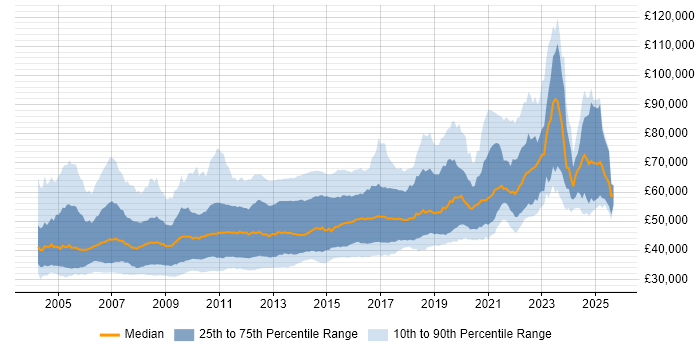Senior C# .NET Developer
UK
The median Senior C# .NET Developer salary in the UK is £66,750 per year, according to job vacancies posted during the 6 months leading to 7 December 2025.
The table below compares current salary benchmarking and summary statistics with the previous two years.
|
|
6 months to
7 Dec 2025 |
Same period 2024 |
Same period 2023 |
| Rank |
644 |
666 |
651 |
| Rank change year-on-year |
+22 |
-15 |
+199 |
| Permanent jobs requiring a Senior C# .NET Developer |
10 |
76 |
59 |
| As % of all permanent jobs in the UK |
0.018% |
0.12% |
0.12% |
| As % of the Job Titles category |
0.020% |
0.13% |
0.12% |
| Number of salaries quoted |
10 |
69 |
54 |
| 10th Percentile |
£48,875 |
£47,850 |
£55,375 |
| 25th Percentile |
£56,563 |
£56,250 |
£64,688 |
| Median annual salary (50th Percentile) |
£66,750 |
£70,000 |
£85,000 |
| Median % change year-on-year |
-4.64% |
-17.65% |
+25.93% |
| 75th Percentile |
£92,500 |
£82,500 |
£120,000 |
| 90th Percentile |
£100,000 |
£98,750 |
- |
| UK excluding London median annual salary |
£60,000 |
£60,000 |
£57,500 |
| % change year-on-year |
- |
+4.35% |
-8.00% |
For comparison with the information above, the following table provides summary statistics for all permanent IT job vacancies. Most job vacancies include a discernible job title that can be normalized. As such, the figures in the second row provide an indication of the number of permanent jobs in our overall sample.
| Permanent vacancies in the UK with a recognized job title |
50,704 |
58,391 |
48,070 |
| % of permanent jobs with a recognized job title |
89.90% |
94.00% |
95.24% |
| Number of salaries quoted |
31,404 |
32,367 |
37,457 |
| 10th Percentile |
£28,250 |
£32,500 |
£31,250 |
| 25th Percentile |
£36,250 |
£42,500 |
£42,500 |
| Median annual salary (50th Percentile) |
£55,000 |
£58,000 |
£60,000 |
| Median % change year-on-year |
-5.17% |
-3.33% |
- |
| 75th Percentile |
£75,000 |
£77,500 |
£80,000 |
| 90th Percentile |
£92,500 |
£95,000 |
£97,500 |
| UK excluding London median annual salary |
£47,500 |
£52,500 |
£52,500 |
| % change year-on-year |
-9.52% |
- |
- |
Senior C# .NET Developer
Job Vacancy Trend
Historical trend showing the proportion of permanent IT job postings featuring 'Senior C# .NET Developer' in the job title relative to all permanent IT jobs advertised.
Senior C# .NET Developer
Salary Trend
Salary distribution trend for Senior C# .NET Developer job vacancies in the UK.
Senior C# .NET Developer
Salary Histogram
Salary distribution for jobs citing Senior C# .NET Developer over the 6 months to 7 December 2025.
Senior C# .NET Developer
Top 9 Job Locations
The table below looks at the demand and provides a guide to the median salaries quoted in IT jobs citing Senior C# .NET Developer within the UK over the 6 months to 7 December 2025. The 'Rank Change' column provides an indication of the change in demand within each location based on the same 6 month period last year.
Senior C# .NET Developer Skill Set
Top 30 Co-Occurring Skills & Capabilities
For the 6 months to 7 December 2025, Senior C# .NET Developer job roles required the following skills and capabilities in order of popularity.
The figures indicate the absolute number of co-occurrences and as a proportion of all permanent job ads featuring Senior C# .NET Developer in the job title.
Senior C# .NET Developer Skill Set
Co-Occurring Skills & Capabilities by Category
The following tables expand on the one above by listing co-occurrences grouped by category. They cover the same employment type, locality and period, with up to 20 co-occurrences shown in each category:


